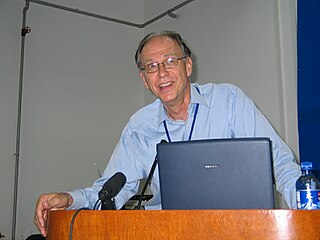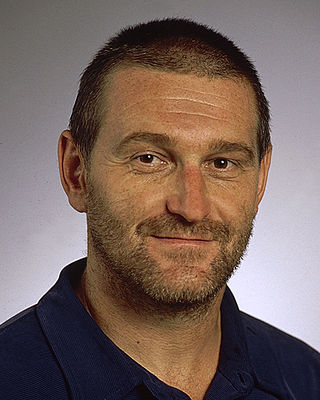Related Research Articles

In bioinformatics, a sequence alignment is a way of arranging the sequences of DNA, RNA, or protein to identify regions of similarity that may be a consequence of functional, structural, or evolutionary relationships between the sequences. Aligned sequences of nucleotide or amino acid residues are typically represented as rows within a matrix. Gaps are inserted between the residues so that identical or similar characters are aligned in successive columns. Sequence alignments are also used for non-biological sequences such as calculating the distance cost between strings in a natural language, or to display financial data.

Computational biology refers to the use of data analysis, mathematical modeling and computational simulations to understand biological systems and relationships. An intersection of computer science, biology, and big data, the field also has foundations in applied mathematics, chemistry, and genetics. It differs from biological computing, a subfield of computer science and engineering which uses bioengineering to build computers.

Richard Manning Karp is an American computer scientist and computational theorist at the University of California, Berkeley. He is most notable for his research in the theory of algorithms, for which he received a Turing Award in 1985, The Benjamin Franklin Medal in Computer and Cognitive Science in 2004, and the Kyoto Prize in 2008.
In computational phylogenetics, tree alignment is a computational problem concerned with producing multiple sequence alignments, or alignments of three or more sequences of DNA, RNA, or protein. Sequences are arranged into a phylogenetic tree, modeling the evolutionary relationships between species or taxa. The edit distances between sequences are calculated for each of the tree's internal vertices, such that the sum of all edit distances within the tree is minimized. Tree alignment can be accomplished using one of several algorithms with various trade-offs between manageable tree size and computational effort.

Michael Spencer Waterman is a Professor of Biology, Mathematics and Computer Science at the University of Southern California (USC), where he holds an Endowed Associates Chair in Biological Sciences, Mathematics and Computer Science. He previously held positions at Los Alamos National Laboratory and Idaho State University.

Eugene Wimberly "Gene" Myers, Jr. is an American computer scientist and bioinformatician, who is best known for contributing to the early development of the NCBI's BLAST tool for sequence analysis.
Eugene Leighton (Gene) Lawler was an American computer scientist and a professor of computer science at the University of California, Berkeley.

Pavel Arkadevich Pevzner is the Ronald R. Taylor Professor of Computer Science and director of the NIH Center for Computational Mass Spectrometry at University of California, San Diego. He serves on the editorial board of PLoS Computational Biology and he is a member of the Genome Institute of Singapore scientific advisory board.
Bernard M. E. Moret is a Swiss-American computer scientist, an emeritus professor of Computer Science at the École Polytechnique Fédérale de Lausanne in Switzerland. He is known for his work in computational phylogenetics, and in particular for mathematics and methods for computing phylogenetic trees using genome rearrangement events.

Tandy Warnow is an American computer scientist and Grainger Distinguished Chair in Engineering at the University of Illinois at Urbana–Champaign. She is known for her work on the reconstruction of evolutionary trees, both in biology and in historical linguistics, and also for multiple sequence alignment methods.

David Sankoff is a Canadian mathematician, bioinformatician, computer scientist and linguist. He holds the Canada Research Chair in Mathematical Genomics in the Mathematics and Statistics Department at the University of Ottawa, and is cross-appointed to the Biology Department and the School of Information Technology and Engineering. He was founding editor of the scientific journal Language Variation and Change (Cambridge) and serves on the editorial boards of a number of bioinformatics, computational biology and linguistics journals. Sankoff is best known for his pioneering contributions in computational linguistics and computational genomics. He is considered to be one of the founders of bioinformatics. In particular, he had a key role in introducing dynamic programming for sequence alignment and other problems in computational biology. In Pavel Pevzner's words, "Michael Waterman and David Sankoff are responsible for transforming bioinformatics from a ‘stamp collection' of ill-defined problems into a rigorous discipline with important biological applications."

Ron Shamir is an Israeli professor of computer science known for his work in graph theory and in computational biology. He holds the Raymond and Beverly Sackler Chair in Bioinformatics, and is the founder and former head of the Edmond J. Safra Center for Bioinformatics at Tel Aviv University.

Ziv Bar-Joseph is an Israeli computational biologist and Professor in the Computational Biology Department and the Machine Learning Department at the Carnegie Mellon School of Computer Science.
Mathieu Daniel Blanchette is a computational biologist and Director of the School of Computer Science at McGill University. His research focuses on developing new algorithms for the detection of functional regions in DNA sequences.

Gad Menahem Landau is an Israeli computer scientist noted for his contributions to combinatorial pattern matching and string algorithms and is the founding department chair of the Computer Science Department at the University of Haifa.
Mona Singh is an American computer scientist and an expert in computational molecular biology and bioinformatics. She is the Wang Family Professor in Computer Science in the Lewis-Sigler Institute for Integrative Genomics and the Department of Computer Science at Princeton University. Since 2021, she has been the Editor-in-Chief of the Journal of Computational Biology.

Hanah Margalit is a Professor in the faculty of medicine at the Hebrew University of Jerusalem. Her research combines bioinformatics, computational biology and systems biology, specifically in the fields of gene regulation in bacteria and eukaryotes.
Vineet Bafna is an Indian bioinformatician and professor of computer science and director of bioinformatics program at University of California, San Diego. He was elected a Fellow of the International Society for Computational Biology (ISCB) in 2019 for outstanding contributions to the fields of computational biology and bioinformatics. He has also been a member of the Research in Computational Molecular Biology (RECOMB) conference steering committee.
Louxin Zhang is a Canadian computational biologist. He is currently a professor in the Department of Mathematics at the National University of Singapore. He is recognized for his contributions to combinatorial semigroup theory in mathematics. In addition, he is recognized for his work on the mathematical understanding of phylogenetic trees and networks, as well as the analysis of spaced seeds for sequence comparison in bioinformatics.
Tao Jiang is a Chinese-Canadian computer scientist and bioinformatician. He is Distinguished Professor of Computer Science and Engineering at the University of California, Riverside and was previously Distinguished Visiting Professor at Tsinghua University and Professor of Computer Science at McMaster University.
References
- 1 2 3 Dan Gusfield publications indexed by Google Scholar
- 1 2 Dan Gusfield at the Mathematics Genealogy Project
- 1 2 Gusfield, Daniel Mier (1980). Sensitivity analysis for combinatorial optimization (PhD thesis). University of California, Berkeley. OCLC 40134251.
- ↑ "Dan Gusfield". web.cs.ucdavis.edu. Archived from the original on 17 June 2017. Retrieved 23 January 2019.
- ↑ Gusfield. Very Simple Methods for All Pairs Network Flow Analysis. SIAM J. Comput. 1990
- ↑ R.W. Irving, P. Leather, and D. Gusfield, "An efficient algorithm for the "optimal" stable marriage", Journal of the ACM, Vol. 34 Issue 3, July 1987, Pages 532-543
- ↑ Gusfield, Dan; Irving, Robert (1999). The stable marriage problem: structure and algorithms. MIT Press. ISBN 0-262-07118-5.
- ↑ "Computer Science- UC Davis". Cs.ucdavis.edu. 4 October 2018. Retrieved 23 January 2019.
- ↑ D. Gusfield, "Efficient algorithms for inferring evolutionary trees", Networks 1991 doi : 10.1002/net.3230210104
- ↑ D. Gusfield, "Efficient Methods for Multiple Sequence Alignment with Guaranteed Error Bounds", Bulletin on Mathematical Biology, Vol. 55, No. 1, 141-154, 1993
- ↑ Dan Gusfield. "Introduction to the IEEE/ACM Transactions on Computational Biology and Bioinformatics" (PDF). Computer.org. Archived from the original (PDF) on 3 April 2015. Retrieved 23 January 2019.
- ↑ Gusfield and J. Stoye. "Linear time algorithms for finding and representing all the tandem repeats in a string", JCSS, 2004
- ↑ Gusfield, D., Eddhu, S. and Langley, C., 2004. "Optimal, efficient reconstruction of phylogenetic networks with constrained recombination". Journal of bioinformatics and computational biology, 2(01), pp.173-213.
- ↑ Gusfield. "Haploytyping as Perfect Phylogeny: Conceptual framework and efficient solutions." Proceedings of RECOMB 2002.
- ↑ Gusfield, D. (2003). "Haplotype inference by pure parsimony." In Combinatorial Pattern Matching (pp. 144-155). Springer Berlin/Heidelberg.
- ↑ D. Gusfield, "Inference of haplotypes from samples of diploid populations: complexity and algorithms." Journal of computational biology 8, no. 3 (2001): 305-323.
- ↑ Gusfield. "The multi-state perfect phylogeny problem with missing and removable data: solutions via integer linear programming and chordal graph theory." Journal of Computational Biology, 2010.
- ↑ Y. Frid and Gusfield. "A simple, practical, and complete -time algorithm for RNA folding using the Four-Russians speedup". Algorithms for Molecular Biology, 2010
- ↑ Gusfield, Dan (1999). Algorithms on Strings, Trees and Sequences: Computer Science and Computational Biology. Cambridge University Press. doi:10.1017/CBO9780511574931. ISBN 0-521-58519-8. S2CID 61800864.
- ↑ Gusfield, Dan (2014). ReCombinatorics: The Algorithmics of Ancestral Recombination Graphs and Explicit Phylogenetic Networks. MIT Press. ISBN 9780262027526.
- ↑ "2015 elevated fellow" (PDF). IEEE Fellows Directory. Archived from the original (PDF) on March 30, 2015.
- ↑ "ISCB Fellows". Iscb.org. Retrieved 23 January 2019.
- ↑ ACM Recognizes 2017 Fellows for Making Transformative Contributions and Advancing Technology in the Digital Age, Association for Computing Machinery, December 11, 2017, retrieved 2017-11-13
